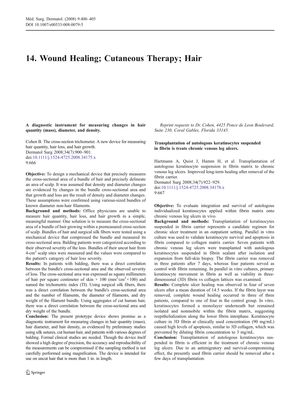Wound Healing, Cutaneous Therapy, Hair
November 2008
in “
Medical & surgical dermatology
”

TLDR A device was made in 2008 to measure hair loss severity. Other findings include: frizzy mutation in mice isn't related to Fgfr2, C/EBPx marks preadipocytes, Cyclosporin A speeds up hair growth in mice, blocking plasmin and metalloproteinases hinders healing, hyperbaric oxygen helps ischemic wound healing, amniotic membranes heal wounds better than polyurethane foam, rhVEGF165 from a fibrin matrix improves tissue flap viability and induces VEGF-R2 expression, and bFGF enhances wound healing and reduces scarring in rabbits.
In 2008, a mechanical device was developed to measure the cross-sectional area of a hair bundle and scalp area, showing a correlation between hair bundle size and hair loss severity. The device's accuracy depended on careful sampling and was intended for uncut hair longer than 1 inch. Further clinical studies were needed to validate its effectiveness. Several studies on wound healing and hair growth were also conducted. Findings included the discovery that the frizzy mutation in mice is not an allele of Fgfr2, the transcription factor C/EBPx is a marker of preadipocytes in vivo, and Cyclosporin A induced fast telogen to anagen transition in mice. Research also found that combined inhibition of plasmin and metalloproteinases prevents healing, hyperbaric oxygen improves ischemic wound healing, and amniotic membranes have better wound-healing effects than polyurethane foam. Additionally, recombinant human vascular endothelial growth factor (rhVEGF165) released from a fibrin matrix increased tissue flap viability and induced VEGF-R2 expression, and basic fibroblast growth factor (bFGF) improved wound healing quality and reduced scarring in a rabbit ear model.



